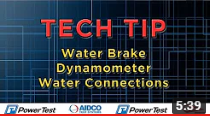Water Brake Dyno – Water Connections
Today we are going to be talking about proper water supply and exhaust connections to your water brake dynamometer. However before we get into the actual connections, in order to optimize the full capabilities of your dyno there are three main water factors that need to be consider. They are:
- CLEAN
- COOL
- REGULATED
CLEAN
Local water quality is an important factor. Power Test recommends the following when it comes to water quality.
PowerNet (servo) Valve Systems:
Total Hardness: 250 ppm or less
PH: 7.0 – 8.5
Particulate: 25 micron maximum. Water should be filtered before entering water regulation circuit, if equipped. To monitor filter blockage, water pressure should be monitored before and after filter.
Non-PowerNet Valve Systems:
Total Hardness: 500ppm or less
PPH: 7.0 – 8.5
Particulates: 420 micron maximum. Water should be strained using a 40 mesh screen before entering water regulation, if equipped. To monitor strainer blockage, water pressure should be monitored before and after strainer.
All dyno locations around the world will have different water qualities, hardness, minerals, and so on. It is a best practice to consult a local water professional and follow their water treatment recommendations based on your location.
We also recommend that you run your dyno water supply through a filtration system. We can provide water filter housings and will work with you to configure them into your application. Again, filtration system can vary based on location, so if you have any question, please contact us.
COOL.
I will be referencing the 45X dynamometer in the following examples, but they will cover most of our water brake dyno’s. Consult your owner’s manual just to be sure. On a 45X, we recommend a water supply temperature of 85° Fahrenheit, which is about 30° Celsius. Just to be clear, this recommendation is the highest the temperature that should ever be going into your dyno to maintain its full capabilities. Water brake dynos ultimately heat the water as they absorb the horsepower being produced, so the cooler the supply water, the better.
REGULATED
Whether you are running a closed recirculation system with a cooling tower, glycol, or running off of fresh water supply, pressure and adequate flow are very important factors.
Supply Pumps come in various sizes and they are sized based on your specific application. Ideally we want supply pressure to be between 45 and 65 PSI or 3 to 4 BAR max going into the dyno. So the water supply pressure must be greater than 65 PSI or 4 BAR BEFORE the water regulation system so the system can proper regulate the pressure down.
We also require roughly 6 GPM or 23 Liters per min. of flow for every 100 HP being tested. These are rough guidelines, so please contact us if you have any questions.
Let’s take a look at a common water circuit.
Here is the dyno supply pump (highlight), and notice after the pump we recommend a Y-strainer to filter out any large particles that could have somehow made it through the pump filtration system.
Then water flows into an Accumulator (highlight/picture), which takes up small spikes in the water flow and smooths them out. Next the water flows into a pressure regulator (highlight/picture).
Ideally we recommend customers install pressure gauges before and after the regulator. With these pressure gauges installed, you will be able to read supply pressure from the pump and supply pressure to the dyno to verify the regulator is regulating the supply. These gauges can also help with any future trouble shooting that may come up.
Next we’ll cover the actual water connections to your dyno.
If you ordered a dyno mounted water pressure regulation system from Power Test, connect the supply connection to the regulation system.
If you are making the hose connection to the dyno, it is essential that this connection is properly sized and does not side load the dynamometer. To help explain side-loading I want you to imagine that the load cell and discharge lines are not attached and the dyno carcass is free to spin. We do not want this connection force the dyno to one side or the other. This force will affect load cell readings.
The water return or discharge connections from the dynamometer are equally as important as the inlet connection. Typically dyno outlets are open air gravity drains. It is common to size the outlet two times the size of the water inlet connection. 3” inlet, 6” outlet.
If you have a vented dyno, the outlet connections are already sized accordingly and can be hard plumb since the “venting” takes care of the gravity drain within the sub-base.
In closing, it is important to have a clean, cool, regulated water supply to your dyno. Coupled with an appropriate water return to ensure you have a reliable, low maintenance, repeatable testing environment. Please don’t hesitate to contact us with any questions you may have and I hope you have a great day!


